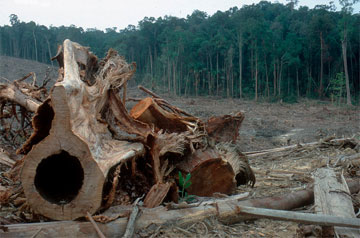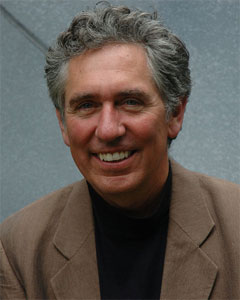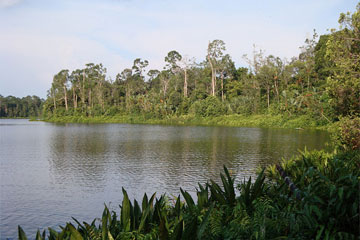Activists from the Rainforest Action Network voice support for the Forest Stewardship Council (FSC) certification scheme but say stronger policy measures are needed to control deforestation.
In the 1980s and 1990s pressure from activist groups led some of the world’s largest forestry products companies and retailers to join forces with environmentalists to form the Forest Stewardship Council (FSC), a certification standard that aims to reduce the environmental impact of wood and paper production on natural forests. Despite initial skepticism on whether buyers would pay a premium for greener forest products, FSC quickly grew and by 2000 had become a standard in many markets, including Europe and the United States. Companies like Home Depot, Lowe’s, and Ikea are today strong supporters of the FSC.
But the FSC has not been without controversy. In recent years some activists have voiced concern about FSC standards as well as the credibility of auditors that certify timber operations. Some forest advocates question the certification of products from ‘mixed sources’, which allows non-FSC-certified wood fiber, to be labeled as FSC-certified. Others — including Ecological Internet, The World Rainforest Movement, and the Rainforest Foundation UK, among others — object to the idea that industrial logging of primary forests can ever be considered “sustainable.” These groups argue that the first-time logging of old growth forests degrade their ecological capacity, reduce their resilience to fire and disease, and leave them vulnerable to future deforestation.
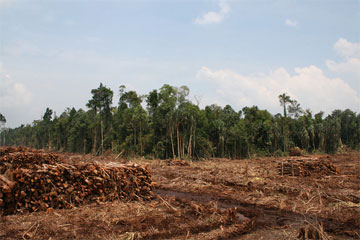
|
But demand for forest products continues to rise. Vast areas of forest continue to be converted for plantations and consumed for timber and pulp. As such, the need for responsibly produced forest products has never been greater and many groups maintain support for the FSC despite its shortcomings. Among the initiative’s supporters is the Rainforest Action Network (RAN), a group best known for its aggressive protest tactics, which in 2006 spurred The Wall Street Journal to dub the San Francisco-based outfit “the most savvy environmental agitators in the business.”
RAN says engagement with the FSC is better than the alternative: leaving the timber industry to devise its own sustainability standards as it has tried to do with various schemes—including the U.S. Sustainable Forestry Initiative (SFI), the Canadian Standards Association (CSA), the Pan European Forestry Certification (PEFC)—which feature weak environmental protections. Unlike these other bodies, FSC decisions are made democratically by its three membership chambers: economic, social, and environmental interests. RAN believes that now is a particularly critical time to work within the FSC: for the first time since its creation in 1993, the FSC is reviewing and revising its ten “Principles and Criteria for responsible forest management” which form the basis for its certification standards.
Speaking with mongabay.com in May 2010, Lafcadio Cortesi, RAN’s Forest Campaign Director, and Bill Barclay, RAN’s policy director, discussed why the group is still working within the FSC process. Cortesi and Barclay argued that certification cannot be a replacement for hard policy measures like government regulation and law enforcement.
 Lafcadio Corteesi
|
“Certification is a soft policy instrument but we really need to also look at hard policy—the long overdue government policy reforms and changes that are necessary to reduce deforestation in tropical countries,” said Barclay. “It is important to distinguish between what the FSC can and cannot do. The FSC has policies, for example, related to a company and illegal logging but it is a voluntary initiative with various degrees and quality.”
“The FSC doesn’t provide the basis for actual law enforcement or for strengthening legality requirements. The FSC can’t enforce, implement, or advance indigenous peoples’ rights in the same way that governments can do with forest tenure reforms and other measures,” he continued. “It is important to ensure that the FSC doesn’t get in the way of the kinds of hard policy opportunities that exist right now.
Cortesi added that FSC certification should not be used to justify support for logging under the the REDD mechanism, a proposed climate change mitigation program that would compensate tropical countries for protecting their forests.
“Some of the biggest concerns are that existing vested interests in the industrial logging industry will—and is definitely attempting to—secure all kinds of REDD money for basically first-time industrial logging of primary tropical forests,” he told mongabay.com. “That would be a very big mistake.”
Cortesi further said that RAN is actively encouraging companies to reduce consumption of forest products whenever possible and to implement safeguards above and beyond those stipulated under FSC certification.
“We also warn that because FSC is not perfect… they need to create additional safeguards relating to community rights, due diligence, and social conflict.”
AN INTERVIEW WITH LAFCADIO CORTESI AND BILL BARCLAY OF RAN
mongabay: What your assessment of the current policy environment for rainforests? What is RAN’s position on the FSC?
Bill Barclay:
This is a really important time for forests. There are billions of dollars coming to the table to address deforestation and forest protection that just didn’t exist a year ago.
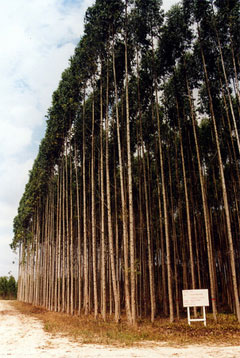 Industrial timber plantation. Image courtesy of the Rainforest Action Network |
Certification is a soft policy instrument but we really need to also look at hard policy—the long overdue government policy reforms and changes that are necessary to reduce deforestation in tropical countries.
So this is a real game changer. And it is important to ensure that the FSC doesn’t get in the way of the kinds of hard policy opportunities that exist right now.
It is important to distinguish between what the FSC can and cannot do. The FSC has policies, for example, related to a company and illegal logging but it is a voluntary initiative with various degrees and quality.
But the FSC doesn’t provide the basis for actual law enforcement or for strengthening legality requirements. The FSC can’t enforce, implement, or advance indigenous peoples’ rights in the same way that governments can do with forest tenure reforms and other measures.
saving the world’s forests requires big investments in conservation. Conservation is one of the big global priorities that has been under-funded for decades and decades. Revenues that come into the forest sector, however, are typically through the logging industry—not for conservation.
The UN Climate Change Convention and various bilateral efforts really need to clarify and focus on addressing this conservation gap for all work that impacts forest areas. Otherwise the logging camp will jump in, saying “We can do logging in these forests and attract climate funding,” even though they are depleting carbon stocks. That would be a mistake.
We don’t want to see new money that is intended to stop climate change put toward industrial, first-time logging in tropical rainforests. It doesn’t really matter whether it is certified or not. The money really needs to prioritize and address more fundamental policy gaps and opportunities to focus on conservation.
Lafcadio Cortesi:
I’d like to zoom in on why RAN is interested in and actually encourages customers and investors regarding the FSC. Really it is because we run market campaigns, which means, in addition to policy levers and to legal instruments, we look for a set of strategies to create leverage points that can be wielded through buying power and investors.
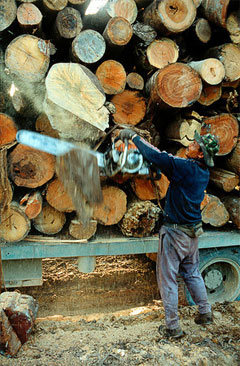 Cut logs in Indonesia. Image courtesy of the Rainforest Action Network |
RAN’s history has been figuring out ways to use market leverage points to conserve forests, to protect forest communities or forest people’s rights, and to improve sustainability in our lives.
When we actually go in and talk to investors—and particularly buyers like Home Depot and Office Depot—we tell them “We don’t want your buying to hurt the forest or to hurt forest peoples.” But they often respond, “Well, what CAN we buy?”
In that discussion, it is important to have something to recommend. An option where there is a third party that is looking at practices and performances of forest companies on the ground, and trying to do that from a perspective of looking at ecological integrity or ecological values; social values; transparency; conservation and adequacy of representation. Those are a bunch of the issues that are taken up in these standards. It is a way to push people and companies to buy products that do less harm. In fact, what we want them to have no harm on the most valuable forests and forest communities.
That is basically the context within which we point to the FSC certification system. What we have found is that, while FSC is by no means perfect, it does provide some risk assurance on some of these issues.
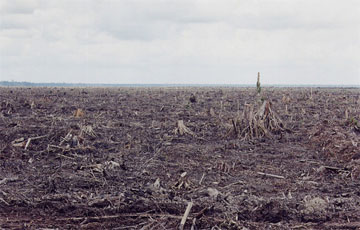 Deforestation in Sumatra. Image courtesy of the Rainforest Action Network |
So what we recommend to buyers, in addition to FSC, is to look at how to reduce their ecological footprint. We encourage them to have policies about procurement. We say “The first thing is to do is look at your footprint in terms of how much you are buying—you should minimize your consumption of these products.”
It is quite different talking to a Home Depot or an Office Depot whose core business relates to selling forest products, than it is talking to a Gucci, who you are talking to about their packaging or to another company whose core business isn’t selling forest products.
In either case we tell companies: “Minimize your consumption. Maximize your efficiency.
We also talk about maximizing—particularly in the paper realm—use of recycled fiber and alternative fibers from sustainable agriculture—”agricultural residues” we call them, like wheat straw, rice straw, etc.
Finally, we tell them basically to “do no harm.” We tell them they need to get out of high conservation and other valuable forests and that the FSC can help in terms of knowing what forests need to be avoided. But we also warn that because FSC is not perfect, that they need to create additional safeguards relating to community rights, due diligence, and social conflict.
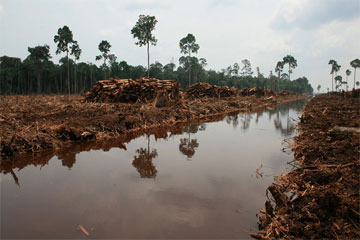 Forest clearing in the carbon-dense peatlands of Sumatra. Image courtesy of the Rainforest Action Network |
Companies also need to get additional due diligence relating to high conservation value forests. This is particularly true in the paper arena where the standard for control of wood is very weak, weakly enforced, and weakly reported.
In the last year or two, we’ve also started addressing the need for companies to account for the carbon footprint associated with their forest product consumption. We are putting the pieces in place to get forest product companies to report on their footprint and their systems of independent verification. We want to move companies to maintaining or restoring carbon stocks in forest ecosystems.
Finally, we ask companies to be transparent about where they are sourcing their forest products to ensure that they are pushing that transparency through their supply chain. Full disclosure allows them to set targets and benchmarks along the way to achieving those targets.
mongabay: What are areas of concern for RAN about the FSC? And what is RAN doing to address these?
Lafcadio Cortesi:
The FSC requires a lot of attention from its membership. We happen to be a member of the FSC in order to engage in the development of policy and standards. If you are not clearly engaged in the FSC then I think it is a dangerous situation.
We take our membership seriously and while we are engaging with a variety of things that are going on in the FSC right now, I would say that the most important—and it is really very significant—is that for the first time since 1993 the FSC is in the process of revising all its Principles and Criteria.
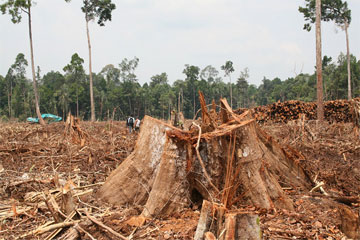 Forest clearing in Sumatra. Image courtesy of the Rainforest Action Network |
These Principles and Criteria are the foundational documents of the whole organization. Which means that this is the opportunity for the Environmental Chamber, which has had many serious concerns with FSC performance over the years, to push the FSC to really improve the environmental and social safeguards embedded in its Principles and Criteria.
Unfortunately, what we are seeing in the drafting process so far is not extremely positive in this regard. So we have to double up our efforts and communicate clearly as a chamber to the FSC Secretariat the importance that we attach to actually really strengthening the environmental safeguards.
To our minds, this is the time you want members to be most engaged, paying attention and pushing hard for the FSC to redress some of the shortcomings that have been identified throughout this process.
mongabay:
RAN has traditionally, at least in the public’s eye, operated sort as an outsider, but in the case of the FSC, RAN is operating more as a sort of an insider—can you explain this decision to work “within the system?”
Bill Barclay:
Well yes, the FSC has always been sort of the underdog at least in contrast to the industry-sponsored schemes like the Sustainable Forestry Initiative of the US Pulp and Paper Association, or the PEFC.
The FSC is more inclusive and has better procedures. It has a chamber system with weighted voting, so there is a balanced approach. So in terms of being “within the system” I guess you could say, yes we are engaged in the certification system. We are not engaging across every certification scheme—we are working in the FSC which we think offers more progressive opportunities.
Lafcadio Cortesi:
And part of the hard piece of that is that we are one of three chambers. The system is a democracy so we don’t get everything we want. We have certainly have heard from thousands of people over the past several months, who say, “We don’t want the FSC to certify old-growth industrial forestry logging.” RAN agrees with that and we think this is the time for not only people who are members or not members—but people who care about forests and ecological integrity as well as the climate—to be articulating that both to the FSC as well as to customers.
mongabay:
So what specific changes are you pushing for within the FSC?
Bill Barclay:
One of the issues is recognition of the values and services that the forest provides. The current FSC Principles and Criteria (P&C) reflect quite a lot of what was on the top of people’s minds at the time that they were first drafted 17 years ago: biodiversity. As a result you see a lot of specific criteria that address biodiversity—species and habitat protection.
One very important point that isn’t reflected in the FSC’s fundamental Principles and Criteria is the climate regulatory role that forests play.
I am not talking about the FSC going in and certifying carbon stocks for some compliance market. I am just talking about setting up—in the same way that there are biodiversity safeguards even though there is not a compliance market for biodiversity—there should be some minimal safeguards that relate to the climate regulatory function that ecosystems can provide.
One example of this is that the FSC has safeguards for forests of high conservation value. One of the high conservation values that needs to be added is “forests with outstanding carbon stocks”, like peat forests and primary forests.
Lafcadio Cortesi:
In terms of what we have been really pushing on is for the FSC probably under the guise of Principles and Criteria, or not, to require the maintenance and restoration of carbon stocks, for example, so that they should not be certifying depletion of carbon stocks.
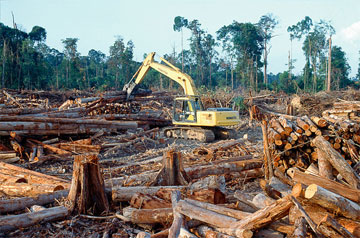 Forest clearing in Sumatra. Image courtesy of the Rainforest Action Network |
Another key area is we are lobbying the FSC to improve and clarify the Control of Wood Standard and make the risk registry more robust.
There needs to be a lot more clarity as well around thresholds, reporting, and transparency of reporting. Right now it is quite confusing to different customers as well as even some of the certifiers.
Another area is the need for improved data collection, particularly relating to the impact of certification on high conservation value forests.
The last area that we are focusing on is the accountability of certifiers. We need to ensure that the FSC holds certifiers who do not adequately enforce the Principles and Criteria and the Regional Standards accountable for not doing that—first with sanctions and then potentially with taking them off of the list of certification bodies that are accredited to give FSC certification.
mongabay:
What’s RAN’s history with the FSC?
Bill Barclay:
RAN was very active in the late Eighties—as were other groups—on tropical timber issues, including imports and forest management.
What we heard from our partners in tropical countries, including forest dependent communities and Indigenous peoples, is that they wanted something that would allow them some income opportunities in forest areas. They were interested in, and we were supportive of, forest certification as a model for that.
In the initial stage of the FSC, I don’t think people expected it to get as big as it has. An important part in the evolution of the FSC came as a result of RAN’s campaign against Home Depot and RAN’s eventual securing of a commitment from Home Depot about the types of product it would stock, including a preference for FSC certified products.
I remember the FSC General Assembly—it was the second one—and at the last minute executives from major U.S. forestry companies that were suppliers to Home Depot – and they had never wanted anything to do with the FSC – showed up in their corporate jets in Oaxaca, Mexico. They came down and wanted to know what the FSC was all about and how the General Assemblies run and if they could even work with the FSC. I think that was the opening stage of a new phase of the FSC. The executives came in expecting to see the whole thing collapse. But it didn’t collapse. It was a very successful General Assembly.
On the other hand, one of the challenges that the FSC faces is that as activists we typically focus on the most egregious logging in our markets campaigns—the most difficult and challenging situations where extraction really needs to be fundamentally reformed or completely stopped.
FSC is a soft policy instrument and where the goals of logging campaigners are to—justifiably—stop logging in certain situations, the FSC can only decline to certify logging in those situations.
So that is a limitation of its approach. A lot of times I think market activists have found themselves having to fight FSC potential certification in areas and situations where FSC certification would be completely inappropriate. And what you get are these victories where nothing appears to have happened. The company fails to meet FSC certification standards, but there is no public record.
So the FSC failure to certify in some situations has been another sort of positive outcome. But again, the FSC as a policy instrument cannot take the next step and then secure the long-term conservation of these areas.
Lafcadio Cortesi:
The most recent example was with APRIL in Indonesia, which had an Interim Controlled Wood Certification that was revoked. Another case was the FSC granting Controlled Wood Certification to Boise Cascade which was buying from Abitibi, which was logging in the Grassy Narrows First Nation traditional territory in Ontario, Canada without their consent. And then we also found that Controlled Wood status was given to Gunn’s for woodchips from old growth forests in Tasmania hips that were being imported by Oji and Nippon Paper in Japan.
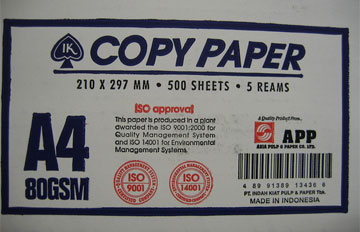 Copy paper made by Asia Pulp & Paper. Image courtesy of the Rainforest Action Network |
In all of these circumstances, having a third party go in and say, “Stuff is not going well” and then having that certification revoked or suspended—as was the case with APRIL or in the case with Boise Cascade and Gunn’s—having the Controlled Wood Standard challenged—moves the ball forward. Because what we saw with Gunn’s was that a whole bunch of their logging was declared that it was not up to Controlled Wood Standards and in the end, Gunn’s Tasmanian wood chips were excluded from FSC controlled wood supply chains into Japan.
Several companies, including Fuji and Xerox, used the fiber coming in from Nippon and Oji. And then in the case of Grassy Narrows and Boise Cascade, basically it facilitated Abitibi (it would be Bowater – at that time Abitibi) pulling out of all logging in the Grassy Narrows First Nation.
mongabay:
And what about issues of subcontracting where FSC-certified companies can conceal destructive operations?
Bill Barclay:
It is a contentious issue in the FSC that they allow that. Asia Pulp and Paper (APP) is a sufficiently bad actor that the FSC has adopted a formal policy of disassociation of APP.
Lafcadio Cortesi:
But just to be clear, I think that it is important to engage in order to improve the transparency and accountability of the accredited certification bodies and what they report on. For example, some certifiers are quite notorious in their lax application of the rules and their unwillingness to share information with stakeholders.
There is a fundamental danger that certifiers will not do their due diligence to find out “Does this company that has asked me for certification in fact have links to a bad actor like APP?”
I think it is a little bit of a red herring in terms of volumes and the main issues but it is certainly it is not impossible that it would happen.
mongabay:
What about a situation where a company can claim FSC certification when it is selling products containing fiber that is mostly not FSC-certified?
Lafcadio Cortesi:
In the Pulp and Paper Sector it is quite hard to segregate fiber. In paper there are recipes for different attributes of paper; whether it is bulky, whether it is glossy, whether it is strong and thin, etc. With the different attributes you need different fiber sets going into it.
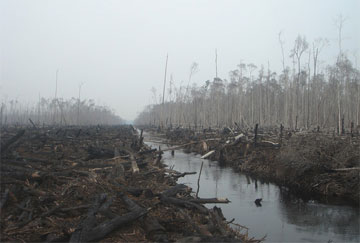 Forest clearing in the carbon-dense peatlands of Sumatra.
|
It was proving very difficult to make sure that all those fibers were coming from FSC-certified forestry management operations. That was a large justification of rational for the pulp and paper industry—including Domtar and Tembec, which are taking their entire operations over to FSC—to say “we can’t do this if you want us to use FSC.” Finally, they agreed that what we need is we need to make sure that the fiber that does go into the mix is not egregious in terms of our main principles.
So they came up with the Controlled Wood Standard. But the Controlled Wood Standard has been quite vague in terms of thresholds and in terms of what constitutes a violation, and poorly enforced. Hence we are really pushing quite hard to tighten up that standard – if it is going to be used at all.
We would prefer that it not be used, but we recognize that with certain products, particularly certain pulp and paper products, and some plywood, for example, or engineered lumber products, that it is having mixed sources, and with a Controlled Wood Standard, may work.
This is the reason why we tell buyers, “FSC is not a panacea. You need to put additional safeguards in place and make sure you do additional due diligence if you want to be environmentally and socially responsible.”
Bill Barclay:
The Controlled Wood Standards are kind of interesting because at the time the FSC Secretariat was quite clear in wanting to get this percentage based mixed sources for labeling in place, and was prepared to have no Controlled Wood Standards whatsoever. It was only the Environmental Chamber getting together and pushing that proposal, and insisting there be some minimum standards for the standard, that it could go through.
The implementation of the Controlled Wood Standard, however, has been a rather abysmal thing. You know, we poked at it a few times to get it better enforced and applied. And I think it needs a lot more work if it is to get to a place that is really credible.
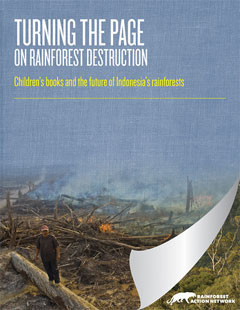 RAN’s Turning the Page on Rainforest Destruction: Children’s Books and the Future of Indonesia’s Rainforests report found that a majority of the top ten U.S. children’s publishers have released at least one children’s book that tested positive for paper fiber linked to the destruction of Indonesia’s rainforests, including some books that describe the benefits of rainforest conservation. |
But, as Lafcadio explained, when FSC certification defined high conservation value forest in a way that would neglect old-growth Tasmanian forests when Gunns was logging them, we were able to say “Well what the hell is going on here?” and push them along to actually take the right action to the benefit of that forest protection campaign.
I definitely want to emphasize that the FSC is at a real crossroads right now, with the re-drafting of its Principles and Criteria, and I think that if they don’t really strengthen the environmental and social safeguards that you are going to see a lot of environmental members questioning their relationship, their membership and future of their support of the FSC.
It is a very critical time and so, again, we think it is very important that we engage the FSC right now, to try to secure a positive outcome on the Principles and Criteria re-drafting process. But it is by no means at all certain that that is what is going to happen.
mongabay:
Can we expand on the hard policy measures that you mentioned earlier?
Lafcadio Cortesi:
Sure, I think it is very important to understand some of the debate that is swirling around. The possibilities in government regulation, and the political will to start to address these is completely changed now that there are billions of dollars on the table available to address deforestation. Some governments are certainly now interested in the climate regulatory function of the forests, so this is a real game changer. But again, as we said before, some of the biggest concerns are that existing vested interests in the industrial logging industry will—and is definitely attempting to—secure all kinds of REDD money for basically first-time industrial logging of primary tropical forests. I think that would be a very big mistake.
The government should really prioritize the communities they want to support, and not, in any way support, industrial logging in these forests.
Bill Barclay:
So there is a lot of concern that the FSC will be used to justify REDD support for logging, which would miss this tremendous opportunity to really prioritize and address the global deficit of funding for conservation efforts.
Lafcadio Cortesi:
We’re afraid we could see standards that are worse for the climate—particularly if we are looking at what is going to be a project-level potential improvement. Project-level improvement without the hard policy reforms in the forestry sector and governance won’t mean anything for reducing deforestation. We’ll have leakage—especially if we also fail to address demand-side drivers that are among the key underlying causes of deforestation and degradation.
mongabay:
So in your mind, what is needed to make the REDD mechanism effective?
Lafcadio Cortesi:
It is really unfair to ask only developing countries to address underlying causes of deforestation when consumption in developed countries is a major driver of deforestation.
There are a lot of policies that impact forests that we need to be paying attention to, including biofuel policies to avoid indirect land use change and deforestation.
There is also a lot of work that can be done to ensure that developed countries are being very strict and showing that they are transparent on imports in the forest sector; that address illegalities, and screen out these really egregious suppliers that are helping to drive deforestation.
Finally, it is really important that long overdue efforts to restore rights to forest communities and indigenous people over the traditional forest territories are addressed up-front. These rights need to be recognized as an essential contribution to addressing deforestation as an essential goal.
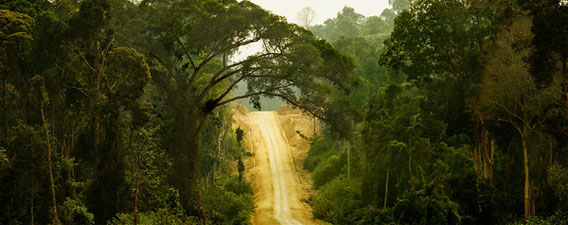
A legally questionable logging corridor built by Asia Pulp and Paper inside the traditional home of the Orang Rimba, one of Indonesia’s last nomadic cultures. Jambi Province, Sumatra, Indonesia. Photo: David Gilbert/RAN |
mongabay:
What about ecosystem services beyond REDD—do you see these as being potentially beneficial provided they have strong safeguards?
Bill Barclay:
Well it would take a lot to unpack all the issues in that question. But again, I think one of the fundamental issues is that rights are properly recognized in these landscapes. And again, getting back to indigenous people and forest communities; if their rights are not recognized as a priority, then payments for services will also not work. Forest communities will not benefit appropriately for payments for services.
There are different ways to organize those payments. They can be direct payments, or they could be offsets for polluting activities in other areas. Each would have very different implications for, for example, climate systems and ultimately for forests. So it’s not just whether there are payments but how they are structured.
Lafcadio Cortesi:
I don’t see this said much, but I think about it, having spent so much time in New Guinea: I look at incentive packages rather than direct payments because I have seen direct payments basically create a lot of community conflict in Melanesia.
But I also am really interested in the value of ecosystem services—water is a no-brainer, but biodiversity and cultural diversity also provide resiliency for climate change. And so in essence you could look at investments in those services as investment in adaptation mechanisms.
And—it is a little bit sort of obscure—but I do think it is important that we start to recognize that basically the seeds for life to continue and culture to continue, and for different ways of being, both for humans and evolution, are contained in biological and cultural diversity.
So I have a soft spot for paying for those systems, as long as they are done with the kinds of safeguards that we have discussed.
Related articles
Children’s books about rainforests linked to rainforest destruction
(06/01/2010) Purchasing a book children’s book may be directly causing deforestation of biodiverse and carbon-heavy rainforests, according to a new report by the Rainforest Action Network (RAN). In a discovery that highlights the irony of the issue, RAN even found children’s books about protecting rainforests contained fiber from Indonesian forests.
Paper company loses green certification after rainforest destruction in Indonesia
(04/18/2010) The Forest Stewardship Council (FSC), a global certifier of sustainably managed forest, has dropped another Indonesian company for the destruction of rainforests. Asia Paper Resources International Limited (APRIL), has had its certification suspended due to evidence of conversion of rainforests for acacia plantations, the destruction of ‘High Conservation Value Forest’, draining peatlands, as well as continuing conflicts with local communities. The decision was made by the Rainforest Alliances Smartwood, an accreditation program with the FSC.
Forest certification system needs reform to ensure sustainability – report
(11/04/2008) Demand for wood products is ultimately one of the largest drivers of global deforestation through both direct clear-cutting and selective logging, which increases a forest’s vulnerability to fire and subsequent clearing and disturbance by other actors, including hunters, subsistence farmers, land speculators, ranchers and agro-industrial firms. Reducing the detrimental environmental impacts of meeting wood demand is critical to protecting the world’s forests as healthy, productive and resilient ecosystems.
Rainforest Action Network to review support for FSC certification
(10/16/2008) The Rainforest Action Network (RAN) said it would review its support for the Forest Stewardship Council (FSC), a forest products certification standard, over concerns regarding its certification of destructive logging operations. The announcement comes after a bitter campaign waged against RAN by Ecological Internet, a forest activist group.
The FSC is the ‘Enron of forestry’ says rainforest activist

(04/17/2008) On April 7th, Mongabay printed an interview with FSC International Communications Manager, Nina Haase, in which she defended the FSC against criticism leveled at it by various environmental organizations, such as The World Rainforest Movement and Ecological Internet. The interview drew strong reactions on both sides, and Simon Counsell, director of the Rainforest Foundation UK, requested a chance to respond to the FSC’s interview in-depth. In his response, he states that the FSC has created a “‘race to the bottom’ of certification standards”, alleging that the “FSC really has become the ‘Enron of forestry'”.
The FSC responds to its critics

(04/07/2008) Last month, Mongabay.com reported on recent and various criticisms of the FSC (the Forest Stewardship Council). The FSC is an international organization that certifies forest products which, according to their standards, have been harvested in an environmentally-sustainable and socially-responsible manner. Response to the article was significant. It was picked up by the Ecological Internet’s email campaign and was mentioned on numerous environmental web sites and blogs. At the time of the publication, the FSC had not responded to requests for comments. But in the following interview, FSC International Communications Manager Nina Haase answers each criticism separately and addresses several other issues, such as the FSC and climate change, the organization’s monitoring capabilities, and its adaptation to new environmental concerns. Ultimately she responds to the big question raised by critics: is the FSC stamp still credible?
FSC has ‘failed the world’s forests’ say critics
(03/26/2008) The Forest Stewardship Council (FSC) has come under increasingly harsh criticisms from a variety of environmental organizations. The FSC is an international not-for-profit organization that certifies wood products: its stamp of approval is meant to create confidence that the wood was harvested in an environmentally-sustainable and socially-responsible manner. For years the FSC stamp has been imperative for concerned consumers in purchasing wood products. Yet amid growing troubles for the FSC, recent attacks from environmental organizations like World Rainforest Movement and Ecological Internet are putting the organization’s credibility into question.
Savvy environmentalists challenge corporations to go green

(01/29/2007) Increasing rates of tropical deforestation in the 1970s and 1980s helped trigger the rise of several forest activist groups specifically interested in rainforests. Among the earliest of these organizations was the Rainforest Action Network (RAN). Founded in 1985 by Randall Hayes, RAN lead its first direct campaign in 1987 against Burger King, which at the time was using beef raised on deforested lands in Central America. In response to the nationwide boycott, which caused sales to drop 12%, Burger King canceled $35 million worth of beef contracts from the region and announced they would no longer import beef from the rainforest. Hailed as a major victory for rainforest protection, RAN initiated consumer boycotts of other firms engaged in destructive practices, eventually developing an effective strategy for promoting change at the corporate level. Today San Francisco-based RAN has expanded well beyond its original mission of protecting rainforests. Recently dubbed “the most savvy environmental agitators in the business” by the Wall Street Journal, the small but efficient organization (36 staff members and a $3 million budget) pressures some of the world’s largest and most respected firms — including Citigroup, Bank of America, JP Morgan Chase, Goldman Sachs, Home Depot, and Boise Cascade — to adopt wide-ranging green policies that impact everything from where they source their energy to how they finance development projects.
